
The Grand Army of the Republic (GAR) was a fraternal organization composed of veterans of the Union Army, Union Navy, and the Marines who served in the American Civil War. It was founded in 1866 in Springfield, Illinois, and grew to include hundreds of "posts" across the nation. It was dissolved in 1956 at the death of its last member, Albert Woolson (1850–1956) of Duluth, Minnesota.

The Grand Army of the Republic (GAR) Building is a historic building in downtown Detroit, Michigan. It was listed on the National Register of Historic Places in 1986.
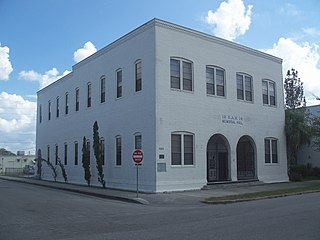
The Grand Army of the Republic Memorial Hall is an historic building located at 1101 Massachusetts Avenue in St. Cloud, Florida, in the United States. The city of St. Cloud had been founded by the Grand Army of the Republic or GAR, as a retirement colony for its members. The hall was built in 1914 by members of the GAR as a memorial to the Union Army veterans of the Civil War. It was one of many such halls built in the country. On February 21, 1997, it was added to the U.S. National Register of Historic Places.
Grand Army of the Republic Hall, GAR Building, or variants thereof, may refer to:

The Grand Army of the Republic Hall is an historic building located at 34 School Street in Rockland, Massachusetts, in the United States. The hall was designed by local builder William Harrison Hebberd, andbuilt in 1899 by members of the GAR as a memorial to the Union Army veterans of the Civil War. It is a somewhat plainly decorated two-story wood frame building with a hip roof. Its most elaborate exterior feature is the main entry, a porch supported by clusters of narrow columns, and with brackets in its eaves. The interior is more elaborately decorated, and has retained most of its original Queen Anne details.
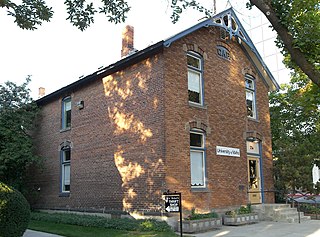
The Grand Army of the Republic Hall is an historic Grand Army of the Republic building located at 714 W. State Street in Boise, Idaho.

The Grand Army of the Republic Memorial Hall, also known as William Baumer Post No. 24, Grand Army of the Republic (GAR), and as the Civil War Veterans Museum, is a historic building located at 908 1st Corso in Nebraska City, Nebraska, in the United States. The hall was built in 1894–95. In 1994, it was added to the U.S. National Register of Historic Places.

The Grand Army of the Republic Hall, also known as the General Frederick W. Lander Post No. 5, Grand Army of the Republic, is an historic building located at 58 Andrew Street in Lynn, Massachusetts, in the United States.

The Grand Army of the Republic Hall is an historic building located at 23 East Downer Place on Stolp Island in Aurora, Illinois, in the United States.
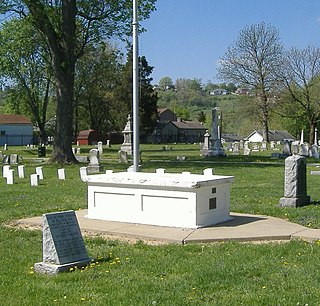
The Grand Army of the Republic Monument, in the Linden Grove Cemetery of Covington, Kentucky, was built in 1929 by the O. P. Sine of Garfield Post No. 2 of the Grand Army of the Republic, a group comprising the remaining veterans of the Union army.
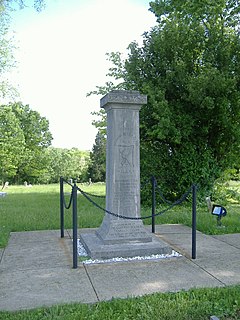
The Colored Soldiers Monument in Frankfort, Kentucky's Green Hill Cemetery, at the junction of US 60 and US 421, is the only Kentucky monument honoring black soldiers that participated in the American Civil War, and one of only four in the entire United States. Erected by the Women's Relief Corps No. 8, an auxiliary of the Grand Army of the Republic, it was unveiled on July 4, 1924. The only other monument built by GAR in Kentucky is the GAR Monument in Covington.

Major General John A. Logan, also known as the General John A. Logan Monument and Logan Circle Monument, is an equestrian statue in Washington, D.C. that honors politician and Civil War general John A. Logan. The monument is sited in the center of Logan Circle, a traffic circle and public park in the Logan Circle neighborhood. The statue was sculpted by artist Franklin Simmons, whose other prominent works include the Peace Monument and statues in the National Statuary Hall Collection. The architect of the statue base was Richard Morris Hunt, designer of prominent buildings including the Metropolitan Museum of Art in New York City and The Breakers in Newport, Rhode Island. Prominent attendees at the dedication ceremony in 1901 included President William McKinley, members of his cabinet, Senator Chauncey Depew, Senator Shelby Moore Cullom, and General Grenville M. Dodge.

The George Gordon Meade Memorial, also known as the Meade Memorial or Major General George Gordon Meade, is a public artwork in Washington, D.C. honoring George Meade, a career military officer from Pennsylvania who is best known for defeating General Robert E. Lee at the Battle of Gettysburg. The monument is sited on the 300 block of Pennsylvania Avenue NW in front of the E. Barrett Prettyman United States Courthouse. It was originally located at Union Square, but was removed and placed in storage for fourteen years before being installed at its current location. The statue was sculpted by Charles Grafly, an educator and founder of the National Sculpture Society, and was a gift from the state of Pennsylvania. Prominent attendees at the dedication ceremony in 1927 included President Calvin Coolidge, Governor John Stuchell Fisher, Secretary of the Treasury Andrew W. Mellon, and Senator Simeon D. Fess.

The Stephenson Grand Army of the Republic Memorial, also known as Dr. Benjamin F. Stephenson, is a public artwork in Washington, D.C. honoring Dr. Benjamin F. Stephenson, founder of the Grand Army of the Republic, a fraternal organization for Union veterans. The memorial is sited at Indiana Plaza, located at the intersection of 7th Street, Indiana Avenue, and Pennsylvania Avenue NW in the Penn Quarter neighborhood. The bronze figures were sculpted by J. Massey Rhind, a prominent 20th-century artist. Attendees at the 1909 dedication ceremony included President William Howard Taft, Senator William Warner, and hundreds of Union veterans.

The Grand Army of the Republic Memorial is a monument in Twin Springs Park of Siloam Springs, Arkansas. Located in the southern part of the park, it consists of a concrete foundation, on which rest two tiers of granite slabs, laid horizontally. These are topped by a vertical granite column that has an onion form at the top. The sides of the horizontal slabs are rusticated, as are three sides of the column. The fourth side is engraved, from the top down, with an inverted five-point star labelled "GAR", then the words "IN GOD WE TRUST", then a Maltese cross engraved "WOMEN'S RELIEF CORPS 1833", then "ERECTED BY/CURTIS POST/1928", and finally a wreath topped by an eagle and crossed cannons, with "US" in the center surrounded by "PRESERVED BY THE GRACE OF GOD". The memorial was placed in 1928, and is the only known memorial statewide to mention the Grand Army's Women's Relief Corps.
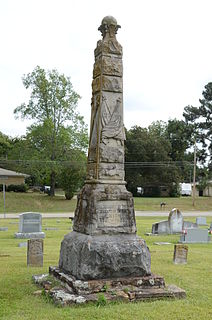
The Grand Army of the Republic Monument of Judsonia, Arkansas is located in the city's Evergreen Cemetery, on Judson Avenue north of its downtown. The monument consists of a rusticated fieldstone base, on which a cubical stone with inscriptions has been set. This is topped by an obelisk-like tapering marble element with a square cross section, which is topped by a sphere adorned with floral detailing. It is set in a square area 31 feet (9.4 m) on each side, in which a number of Union Army soldiers are buried. The monument was placed in 1894 by the local chapter of the Grand Army of the Republic, a Union Army veterans' organization. White County, where Judsonia is located, was divided in the war, with men from the county serving on both sides in the conflict.

The David O. Dodd Memorial is a monument on the grounds of the Old State House in Little Rock, Arkansas. Erected in 1923 by Confederate memorial groups, it commemorates David O. Dodd, an Arkansas civilian who was executed by the U.S. Army for spying. The monument has a horizontal base of gray marble, with a central columnar component, in which a relief portrait of Dodd is carved into white marble. It was listed on the National Register of Historic Places in 1996.

The Pine Bluff Confederate Monument has long been located in front of the Jefferson County courthouse, at Barraque and Main Streets in Pine Bluff, Arkansas. It depicts a standing Confederate Army soldier, holding a rifle whose butt rests on the ground. The statue, built out of Georgia marble by the McNeel Marble Company, stands on a stone base 15 feet (4.6 m) in height and 10 by 10 feet at the base. It was placed in 1910 by the local chapter of the United Daughters of the Confederacy.


















